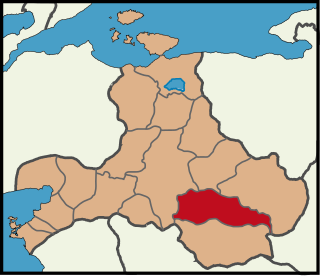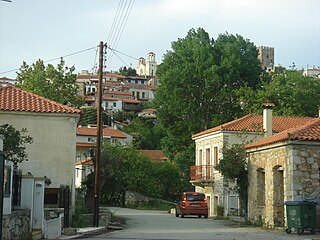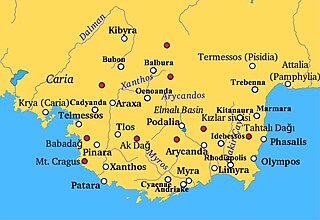
Bigadiç is a municipality and district of Balıkesir Province, Turkey. Its area is 1,108 km2, and its population is 48,917 (2022). As former Ancient bishopric of Achyraus, it remains a Latin Catholic titular see.

İpsala is a town in Edirne Province in northwestern Turkey. It is the seat of İpsala District. Its population is 8,546 (2022). It is the location of one of the main border checkpoints between Greece and Turkey. The Greek town opposite İpsala is Kipoi.
Berissa, also spelled Berisa, Verisa, or Verissa, was a city in the late Roman province of Pontus Polemoniacus, in Asia Minor, which Kiepert and W. M. Ramsay have identified with the modern village of Baulus, 25 kilometres south-west of Tokat.
Harpasa was a city and bishopric in ancient Caria in Roman Asia Minor, which only remains a Latin Catholic titular see.
Euroea in Phoenicia was a city in the late Roman province of Phoenicia Secunda. today Hawarin, north of al-Qaryatayn and on the road from Damascus to Palmyra. There are ruins of a Roman castellum and of a basilica.

Avlonari is a village and a community (unit) of the Municipality Kymi-Aliveri, in the eastern part of the Aegean island of Euboea, Greece. It was the seat of the municipality of Avlon, and the medieval town and bishopric of Aulon, which remains a Latin Catholic titular see.
Germanicopolis was an ancient town in Bithynia, also known as Caesarea in Bythinia (not to be confused with Caesarea Germanica, as such a former bishopric and present Latin Catholic titular see.
Arabissus or Arabissos, also known as Tripotamos, was a town in ancient Cataonia, then Cappadocia, and later in the Roman province of Armenia Secunda. The Byzantine Emperor Maurice was born there in 539. A cave of the Seven Sleepers is located in the Eshab-ı Kehf Kulliye.
Caloe was a town in the Roman province of Asia. It is mentioned as Kaloe or Keloue in 3rd-century inscriptions; as Kalose in Hierocles's Synecdemos (660); and as Kalloe, Kaloe, and Kolone in Parthey's Notitiæ episcopatuum, in which it figures from the 6th to the 12fth or 13th century.
Cestrus was a city in the Roman province of Isauria, in Asia Minor. Its placing within Isauria is given by Hierocles, Georgius Cyprius, and Parthey's. While recognizing what the ancient sources said, Le Quien supposed that the town, whose site has not been identified, took its name from the River Cestros and was thus in Pamphylia. Following Lequien's hypothesis, the 19th-century annual publication Gerarchia cattolica identified the town with "Ak-Sou", which Sophrone Pétridès called an odd mistake, since this is the name of the River Cestros, not of a city.
Eudoxias was a city and bishopric in the late Roman province of Galatia Secunda, in Asia Minor.
Temnos or Temnus was a small Greek polis (city-state) of ancient Aeolis, later incorporated in the Roman province of Asia, on the western coast of Anatolia. Its bishopric was a suffragan of Ephesus, the capital and metropolitan see of the province, and is included in the Catholic Church's list of titular sees.

Podalia, also spelled Podalaea or Podalaia (Ποδαλαία), Podallia (Ποδαλλία), and Podaleia (Ποδάλεια), was a town of ancient Lycia, mentioned by several ancient authors.
Acarassus or Akarassos was a city in ancient Lycia.
Choma was a place in the interior of ancient Lycia, according to Pliny on a river Aedesa. Ptolemy places Choma as one of the four cities of the Milyas, and places it near Candyba. The town can be identified with a site near today's village of Hacımusalar in the district of Elmalı.

The Diocese of Laodicea in Phrygia, is an important Titular Christian Diocese, centered on the biblical city of Laodicea on the Lycus in modern Turkey. The Church at Laodicea was a centre of Christianity from a very early point. The New Testament indicates a Christian presence in Laodicea as early as the AD 50s. The church is mentioned extensively in the epistle to the Colossians, and the First Epistle to Timothy may have been written here. Further, the church was one of the Seven churches of Asia. A bishop was appointed in Apostolic Times, with numerous suffragean bishop attached.
Comba or Komba was a city in ancient Lycia.
Eudocia was a town in ancient Lycia.
Claneus or Klaneos or Klaneous was an ancient city and bishopric in Asia Minor.
Zarela, also known as Durzela, Zorzila, Dyrzela, and Zorzela, was a city and bishopric in ancient Pisidia, which remains a Latin Catholic titular see. It site is unlocated.





